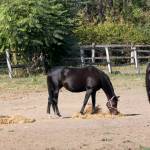Botulism in Horses

Botulism is caused by toxins produced by the bacterium Clostridium botulinum. Three types of botulism are recognized in horses. Adult horses usually ingest toxins produced by the bacteria in feedstuffs (sometimes referred to as forage poisoning). For years, it was thought that fragments of an animal carcass must be consumed, particularly in baled hay, but it is now acknowledged that horses can also pick up the toxins when they eat hay that has been trampled. Improperly ensiled haylage is also often associated with equine cases of botulism. In the second type, foals usually ingest C. botulinum bacteria that multiply in the gut and then produce toxins (toxicoinfectious botulism). Finally, wound botulism is uncommon and results from C. botulinum-contaminated surgical or traumatic wounds. Botulism toxin is one of the most potent biological toxins known, and horses are probably the most susceptible species.
Important clinical signs of botulism are weakness and difficulty eating or swallowing. Botulism causes weakness because its toxins prevent the release of acetylcholine from nerves, which signals the muscles to contract. Affected foals are often unable to stand for very long and shake due to muscle weakness when they try to remain standing or even when they lay down (these are called “shaker foals”).
Adult horses sometimes appear to move in slow motion and also can have muscle shaking or difficulty walking. Severely affected horses are unable to stand on their own or raise their head and sometimes cannot stand even when assisted by a sling. Physical examination will usually reveal loss of tail and eyelid tone, with the tail easily raised or the eyelids kept open with minimal effort. One simple test for botulism is the “grain test,” in which the horse is offered eight ounces of grain. A normal horse should consume the grain within two minutes; horses with botulism cannot eat the grain normally or swallow. Affected horses will often try to eat the grain without using their lips. Difficulty swallowing can be exhibited by saliva, occasionally mixed with grain, draining from the nostrils. Death can occur due to complications of prolonged recumbency, aspiration pneumonia, or respiratory failure. Unfortunately, there is no readily available or practical test for botulism other than clinical signs in a horse in an area where botulism is known to occur.
Treatment for botulism is expensive and time-consuming. Most affected horses need to be hospitalized because they require constant nursing and feeding care, and may deteriorate to the point of needing sling assistance to stand. A mainstay of therapy involves administration of botulism antitoxin, which binds botulism toxin in circulation. However, once botulism toxin has bound to the nerve, it cannot be reversed and the horse’s body must regenerate its own nerve-muscle junctions, which can take weeks. Antibiotics such as penicillin and metronidazole can kill C. botulinum bacteria, if present. Horses usually cannot swallow or drink, so they require intravenous fluids and feeding via stomach tube or total parenteral nutrition. The prevention of pressure sores through assistance with standing is also very important and can be labor-intensive. Foals occasionally have such severe respiratory weakness that they require assisted breathing with a mechanical ventilator. Death can occur even with aggressive treatment. Foals generally have a better prognosis than adult horses.
Prevention of botulism involves vaccination and good feeding practices. Most cases of botulism in the United States are caused by type B botulism, with fewer cases of types A and C. The only commercially available vaccine against botulism is for type B. An initial series of three monthly vaccinations is recommended for unvaccinated horses, followed by yearly boosters.
Hay known to contain animal carcasses should be completely disposed of and not fed. Feeding hay off of the ground or over a pad to prevent trampling or contact with soil reduces the likelihood of contamination from botulism toxin in the environment, especially when the ground is wet from rain or snow. If haylage is fed, it should be purchased only from reliable manufacturers that guarantee good ensiling practices. Mares should have their vaccinations against botulism completed or boostered by the tenth month of pregnancy to allow some antibody to passed to the foal in colostrum. It is important to vaccinate mares in advance if they will be shipped to foal into an area where botulism is known to occur.








